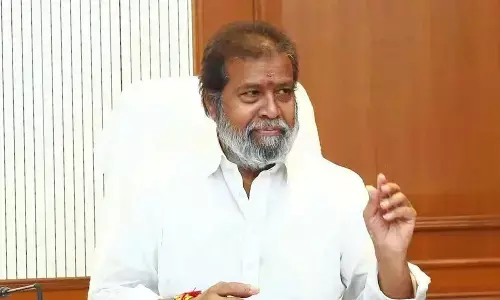A case for climate action

Representational Image
I remember skeptically sitting through a meeting chaired by the political head of the state in 2018 on establishing plant nurseries in every village.
I remember skeptically sitting through a meeting chaired by the political head of the state in 2018 on establishing plant nurseries in every village. Why did we need so many nurseries, what would we do with so many plants and most importantly how would we ensure their survival? I was not alone – government officials like me and public representatives shared the same apprehensions. Turns out we could, and we did.
Today, Telangana has 15,241 nurseries with approximately 400 million healthy saplings for its ambitious greening programme – Haritha Haram (green garland in Telugu). The programme targets an increase by nine per cent of green cover in the state through a plantation of 2.3 billion trees. This is one of the biggest afforestation programmes undertaken by any government in the world.
In a country where seeing is believing, 95 per cent of India's 1.4 billion population do not believe that climate change is a problem that can affect them directly. In a country where 22 per cent of the population lives under $2 dollar per day (in PPP terms), and it is estimated that 75 million more people have been pushed into poverty after Covid-19, development concerns such as food and shelter outweigh the invisible challenge of climate change.
In a country where political leadership grapples with the frequent election cycles and promises, demonstrating farsightedness and resolve like in Telangana for climate action is rare. Though, it is the youngest state in India increasing the green cover was among its top five priorities.
As India proudly stands to be one of the few countries to achieve most of the ambitious goals set out in the Paris Agreement through systemic reforms, people's participation continues to be a challenge. Today, other states can adopt lessons for climate action from Telangana's Haritha Haram.
Afforestation efforts in India have a long history. However, they are top down with limited manoeuverability and working in silos, with the Forest Department having the primary responsibility. Haritha Haram on the other hand was personally led by the Chief Minister of the State, and implementation cut across departments and institutions.
Mass plantations in educational institutions such as schools; offices; industries etc. made the programme more visible to the people. Unlike earlier efforts, the programme was not limited to only the plantation season – preparatory activities started months before. By stressing on capacity building, such as the Gram/ Ward Sabha deciding the mix of plants needed in the village or city, the inhabitants were closely involved in the entire process.
Every unit cultivated a Green Brigade – volunteers comprising students, youth, women self-help groups, industry associations etc. who played an active role in the entire process. Given the fact that casualties are inevitable, the programme has a provision for casualty replacement – ensuring that maintenance and survival of trees planted is as important.
As capacity was being built up simultaneously, the enactment of the Panchayati Raj and Municipalities legislations in 2018 closed many lose ends by fixing accountability for survival of plantations on public representatives and local government officials. Stringent provisions such as removal from elected positions were enabled through the legislature. Further, the statutes made it mandatory for 10 per cent of the budget to be spent on greening activities or "Green Budget".
While the programme saw many successes – increase in tree cover; rejuvenation of more than 0.4 million hectare of forest, plantation of more than 7000 kms of roads with avenue species; greening of 50,000 schools; procurement of water tankers at every village to ensure watering of plants during dry spells, there are many challenges.
Maintenance of plantations remains a cause for concern especially during extreme heat conditions. Balancing the demands of indigenous tribal communities within forest areas and additional budgetary support for rejuvenation activities within forests are still issues that the government is working towards. However, the biggest successes of the programme have been
a) the perceptible change in the attitude of elected public representatives at local government level and citizens
b) the presence of a programme in rural areas and Tier II/ III cities which filled the void created by the absence of civil society organisations working for climate change.
Undoubtedly, efforts to mitigate climate change through afforestation programmes are only tip of the iceberg. The UNFCC estimates that "planting an area greater than the size of Canada and the US shall be expensive and difficult" to "potentially remove about 9 billion tons of carbon dioxide from the atmosphere". But public behaviour in India must change and accept decisions that are for the greater good.
For example, efforts to transition away from coal shall entail changes for the millions employed directly and indirectly in the coal industry. Haritha Haram gives hope that public behaviour can change.
Recent extreme climate events such as floods in Uttarakhand and Mumbai, extreme heat waves and droughts have bought the reality of climate change closer home. As deadlines loom closer and time runs out for climate action leaders across the country should be called to action. The time to transcend vote banks and deliver change is now.
(The writer is presently Collector, Hyderabad, and has been closely involved with implementation of the programme since October 2016. The views are her own.)
















